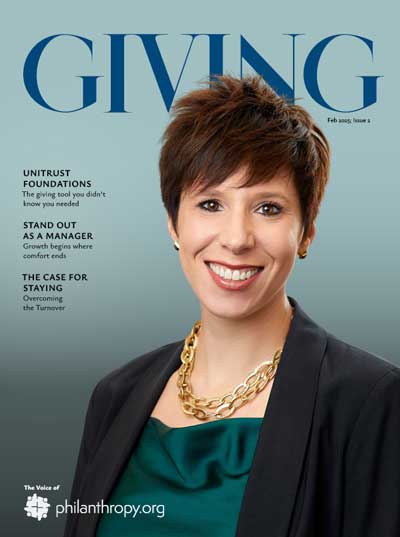It's all about the donor.
In Part I of this series (Your Bio Is Boring. Let’s Fix That.), we discussed a simple truth: planned giving is about people. Not policies. Not portfolios. Not cold emails or sterile tax jargon. At the end of the day, donors don’t leave legacies to institutions—they leave them to people they trust.
Yet too often, planned giving professionals hide behind grey flannel suits. Safe, neutral, professional … and utterly forgettable. What’s missing is personalization—the very thing that turns anonymous gift officers into trusted advisors and transforms mild interest into lifelong support.
In this article, we’ll explore how personalization in planned giving isn’t just a buzzword. It’s a strategy. A mindset. And, when done right, a long-term relationship-building machine.
Why Personalization Matters More Than Ever
In the corporate world, personalization is second nature. Amazon greets you by name. Your bank remembers your last login. Your favorite airline already knows your seat preference.
But in the nonprofit space, especially in planned giving, personalization often falls flat—or worse, is completely ignored. That’s a problem. Why?
Because planned giving is not transactional. It’s emotional. Donors are deciding what kind of legacy they want to leave. They want to feel seen, heard, and understood. And the organizations that make them feel that way are the ones that receive the largest gifts.
So what does personalization look like in real-world planned giving? Let’s break it down.
1. Seeing: Show Them the Face Behind the Suit
Humans are visual creatures. We process images faster than text and remember faces better than facts. So if you want to build trust, don’t hide behind generic templates and third-person bios.
Add photographs to your planned giving website and donor communications. Not stock images—but real staff, in real settings.
- A smiling gift officer on campus
- A legacy donor with their family
- Your CEO shaking hands with alumni
These visuals create connection. They say, “We’re not a machine. We’re a team. We’re people like you.”
Pro tip: Balance friendliness with professionalism. You don’t need a suit and tie in every shot, but you should look credible, competent, and approachable.
2. Hearing: Use Warmth in Every Interaction
Every interaction with a donor is a branding moment. That includes the voice they hear on the phone.
Instead of “Hold, please,” try, “Good afternoon, this is Sandy. How can I help you today?”
And when a donor calls back, remember them.
- “Mrs. Meyer, thank you for your call.”
- “How’s your grandson Jeffrey doing? Didn’t he have a birthday recently?”
This may seem small, but it’s not. It’s massive. Personalization in planned giving means making donors feel like they matter—and not just when they’re signing a bequest.
3. Communicating: Write Like a Human
Most planned giving communications sound like they were written by a committee of lawyers and robots. Don’t do that.
Whether it’s an email, letter, or even a simple thank-you card, your tone should be warm, direct, and personal. Let your team’s voice shine through.
For example:
“Dear Mrs. Meyer,
My name is Richard Jones, and I’ll be working with you to finalize your gift language. I want to make sure everything is clear, simple, and exactly as you envision it.”
Even if Richard didn’t personally write that letter, the sentiment is clear. The donor knows who’s involved, and more importantly, who cares.
Ghostwriting is fine. But everyone on the team should know what “they” said—and follow through accordingly.
4. Celebrating: Remember the Days That Matter
Birthdays. Anniversaries. Holidays.
Yes, your donors have families. But they also have relationships with you—and acknowledging those special days matters.
- Send a handwritten birthday card.
- Drop a quick holiday note in the mail.
- Celebrate their “giving anniversary” with a thank-you email.
These simple gestures cost little, but return much. They reinforce connection and keep your organization top of mind—in the best way possible.
5. Listening: Ask Questions, Remember Answers
This one separates the good fundraisers from the great ones.
A good fundraiser asks questions. A great one remembers the answers.
Don’t just talk about charitable trusts and donor-advised funds. Ask about their passions. Their history with your organization. Their family. Their dog. Then, reference those details the next time you speak.
That’s not manipulation. That’s memory. It’s the kind of relationship-based fundraising that inspires trust, loyalty, and yes—larger gifts.
The Bottom Line: Personalization Builds Trust, and Trust Builds Legacy
Here’s the hard truth: planned giving outreach that feels impersonal is outreach that fails.
Donors can tell when they’re just another name on a spreadsheet. They can sense when your letter is a template. And they know when your interest in them only lasts until the dotted line is signed.
But when you personalize—when you make them feel seen, heard, and valued—everything changes.
- Meetings get easier to book.
- Conversations go deeper.
- Gifts get larger.
That’s not magic. That’s personalization in planned giving. And it’s the difference between a good program and a great one.
Final Thought: People Give to People
Planned giving may deal in tax language and legal structures, but its engine runs on human connection.
So take off the grey flannel suit—at least metaphorically. Show your face. Remember the birthday. Use the donor’s name. Ask about their story.
Because they’re not giving to a logo. They’re giving to you.



